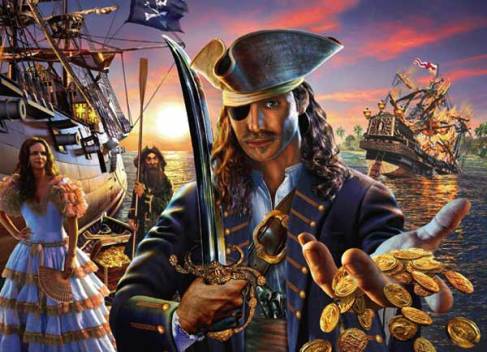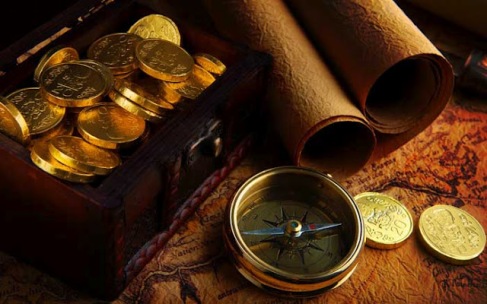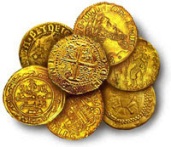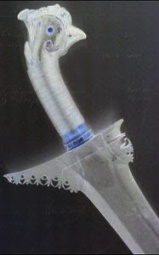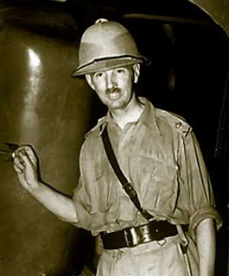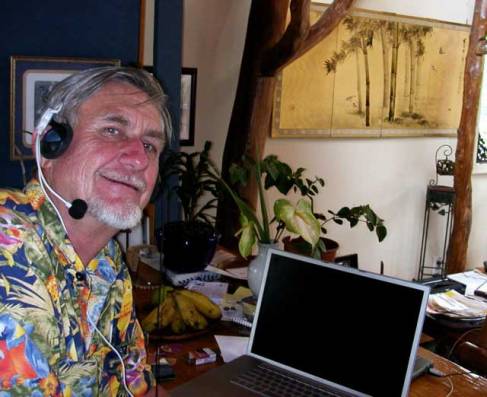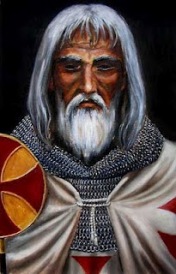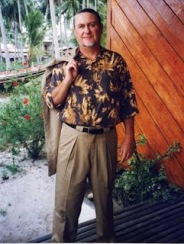Well, I read ingredients on powdered milk tins and packets of Twisties, Sabri Zain’s Reformasi Diary printouts in the loo, and all the noisome pop-up ads on websites (no, I lie about this last). But I hardly ever read novels. Neither does my dad, nor did his dad, nor his dad before him. It may be genetic. My dad used to collect stacks of Popular Science and Popular Mechanic magazines full of practical fix-it-yourself tips. In his mid-eighties he still enjoyed tinkering around with his car and home improvements (like toe-operated fan controls).
 I collect pirated photocopied Popular Metaphysics manuals on practical ways to activate and maintain one’s Merkaba (which Bob Frissell has deftly defined as “the image through which all things were created, a geometrical set of patterns surrounding our bodies… a counter-rotating field of light that encompasses both spirit and body and [serves as] a vehicle – a time-space vehicle.”) The ancients say the best Merkabas run on clear intentions, total compassion, and wishful thinking.
I collect pirated photocopied Popular Metaphysics manuals on practical ways to activate and maintain one’s Merkaba (which Bob Frissell has deftly defined as “the image through which all things were created, a geometrical set of patterns surrounding our bodies… a counter-rotating field of light that encompasses both spirit and body and [serves as] a vehicle – a time-space vehicle.”) The ancients say the best Merkabas run on clear intentions, total compassion, and wishful thinking.
But I digress. I do occasionally read a novel or two, so on those occasions, there’s much to celebrate and to share. Have you read The Moor’s Last Sigh by Salman Rushdie? I have … one and a half times! I enjoyed it so thoroughly, when I reached the end with great reluctance, I simply had to return to the first page and begin all over again, just savoring the man’s consummate craftsmanship and imaginative stamina.
It begins on a high pitch full of frills and promised thrills, then backs up a little and launches into a psychokinetic fractal tapestry of humanity in all its soap operatic complexity, tragedy, and comedy. Everyone and his closet queen uncle is in Rushdie’s multi-generational tale of two families. Dostoevsky meets Gabriel Garcia Marquez and the result is a compelling, masterful fusion of social anthropology, history, and magic realism.
The plot thickens to the point where you begin to suspect it’s about to curdle, but Rushdie adroitly whips it up again into a whole different texture and perspective, until it becomes so sinister, so surrealistic you think he’s gone overboard… but, no, his instincts and his integrity as a master student of the human condition lead him unerringly to a climax so explosively apocalyptic, so archetypal, you KNOW his mind never once wandered off its predestined course, his hand never wavered at the helm… okay, keyboard then. People, I honor and value Salman Rushdie’s diabolically precise and articulate intelligence. Anyone who STILL wants him put down for verbalizing his version of the truth is a mortal enemy of the only non-transferable values we possess: our ethical, intellectual and spiritual liberty.
The Moor’s Last Sigh was to me a novel so satisfying, I didn’t need to read another for the rest of the decade. But I’d already chomped through Wayne Stier’s picaresque, whimsical, pun-slinging, made-for-the-hammock Malacca Gold – which cleverly combined maverick scholarship with romantic fiction, and yet managed to smuggle in a few enriching insights and historical vignettes. I thought it was educational and entertaining, and just the thing to translate into a major box-office movie. [Malacca Gold is reviewed in depth here;]
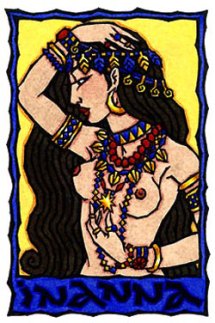 Then my internet friend V. Susan Ferguson sent me her two self-published novels – Inanna Returns and Inanna Hyper-Luminal – which were the perfect dessert, after having gorged myself on a stack of paleo-anthropological studies by Zecharia Sitchin on the Mesopotamian myths. Apparently, Ms Ferguson was reading Sitchin’s The Wars of Gods and Men when she experienced a series of spontaneous retrievals from her genetic cache. The Sumerian goddess Inanna appeared as a holographic vision and merged with her cellular consciousness. She began to reconstruct a brief history of the Anunnaki, the Sumerian Sky Gods of the An lineage who, Sitchin reports, colonized this planet nearly half a million years ago and subsequently created a labor-saving device: US!
Then my internet friend V. Susan Ferguson sent me her two self-published novels – Inanna Returns and Inanna Hyper-Luminal – which were the perfect dessert, after having gorged myself on a stack of paleo-anthropological studies by Zecharia Sitchin on the Mesopotamian myths. Apparently, Ms Ferguson was reading Sitchin’s The Wars of Gods and Men when she experienced a series of spontaneous retrievals from her genetic cache. The Sumerian goddess Inanna appeared as a holographic vision and merged with her cellular consciousness. She began to reconstruct a brief history of the Anunnaki, the Sumerian Sky Gods of the An lineage who, Sitchin reports, colonized this planet nearly half a million years ago and subsequently created a labor-saving device: US!
Well, Sitchin’s books are based on 30 years of meticulous research in dusty museum vaults deciphering half a dozen dead languages. But they ARE founded on archeological artifacts, and this emphasizes their important function: which is to convince Homo sapiens sapiens that the Adamic races were the by-product of a genetic experiment gone awry. Remember The Island of Dr Moreau by, er… was it Jules Verne or H.G. Wells? Anyway, Marlon Brando played Dr Jeanne Moreau in the recent Hollywood remake. I won’t discuss Sitchin’s monumental work here. Those interested can buy, borrow, or steal his books from Toh Seng Keat (the only person I know who owns the complete set) or from Amazon.com.
V. Susan Ferguson’s ghostwriting effort on Inanna’s behalf was luminous and divinely inspired, I thought. She beautifully fleshes out the skeletons Sitchin dug out of humanity’s closet (or was it just Mother Hubbarb’s cupboard?) The ancient gods of Sumer – Enki, Enlil, Ninhursag – who later became the ancient gods (or Neteru) of Egypt, Babylon, Assyria, Canaan, Judaea, and India; and later Peru and the Mayalands, are resurrected skillfully and empathetically by Ms Ferguson, and integrated into a contemporary context. This is what makes her Inanna books so valuable: she transforms the mythical into modern mystery teachings of irresistible cogency and veracity. She makes us understand, as in a gratuitous epiphany, exactly why we are the way we are. Part of it was a genetic legacy of the “gods” who manufactured us from the silly putty of simian DNA; the rest of it was pure bad luck or evil karma or hubris or whatever, but there IS a way out of the evolutionary predicament we’re in. We have to awaken from our cultural trance, our religion-induced spiritual somnambulism, be jolted out of our collective amnesia back into anamnesis, into full recollection of who we truly are.
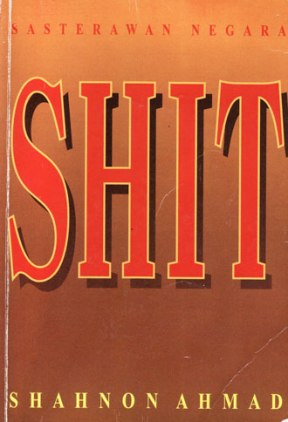 As an epilogue of sorts, I have to include Shahnon Ahmad’s political shit-stirrer, the ingeniously titled, SHIT. I confess that I have only read portions of it, a testimony of how basic my Bahasa skills are. But from the little I have savored, I can feel the tradition-shattering force of Shahnon’s poker-faced prose which reminded me in places of Samuel Beckett’s 1950s experiments with literary nihilism. But in Shahnon’s case the prime concern is obviously not so much with nothingness, the void, the vacuity of human existence – but with the forced evacuation of our political innards.
As an epilogue of sorts, I have to include Shahnon Ahmad’s political shit-stirrer, the ingeniously titled, SHIT. I confess that I have only read portions of it, a testimony of how basic my Bahasa skills are. But from the little I have savored, I can feel the tradition-shattering force of Shahnon’s poker-faced prose which reminded me in places of Samuel Beckett’s 1950s experiments with literary nihilism. But in Shahnon’s case the prime concern is obviously not so much with nothingness, the void, the vacuity of human existence – but with the forced evacuation of our political innards.
We’ve seen all kinds of movements here but the ultimate goal is to achieve healthy and regular bowel movement. It takes real guts to do that. And in these dark and rumbling days of borborygmic unease, when the whole nation seems divided between those who dwell froglike, in their own bloated yellow bellies and those who aspire towards the higher mind or a return to the soul, it cheers me up immeasurably, like a well-pitched burp or perfectly-timed fart, every time I see SHIT prominently displayed in all the Mamak newsstands. Can anyone tell me why the Mamaks seem to have a monopoly on sales of Shahnon’s history-making novel? Roti canai and teh tarik not enough ah? Shiterature oso wan ah?
Posted in December 1999 on artisproactiv@yahoo.com in response to Amir Muhammad’s request for reviews of books we enjoyed in the 1990s.


